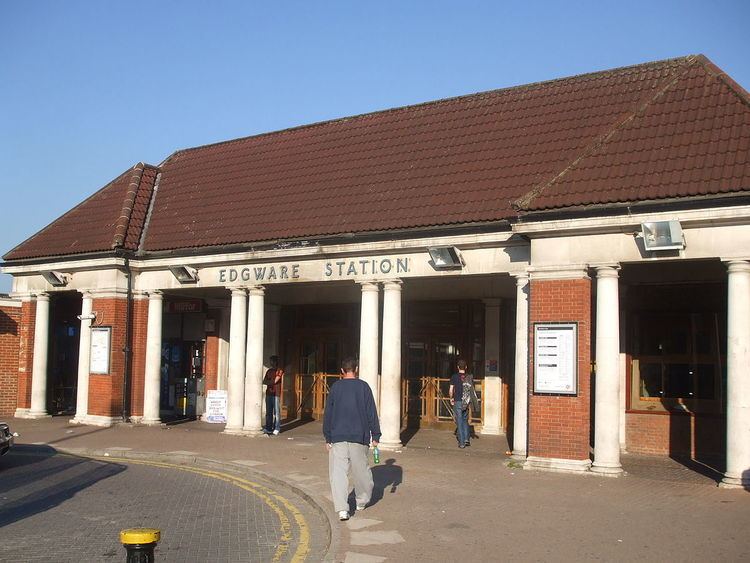Accessible Yes 2012 4.08 million Number of platforms 3 | Fare zone 5 2013 4.09 million | |
 | ||
Address Edgware HA8 7YA, United Kingdom Similar London Underground, Burnt Oak tube station, Edgware Road tube station, High Barnet tube station, Golders Green tube station | ||
Edgware tube station 18 1 13
Edgware is a London Underground station in Edgware, in the London Borough of Barnet, in North London. The station is the terminus of the Edgware branch of the Northern line and the next station towards central London is Burnt Oak. Edgware is in Travelcard Zone 5.
Contents
- Edgware tube station 18 1 13
- Location
- History
- New Works Programme
- Postponement and cancellation
- Accident
- Modernisation
- Connections
- References
Location
The station is in Station Road, Edgware (part of the A5100). This road runs north-east from the High Street (A5), and the station is about 500 metres from the A5 on the right (south-east) side. The building is set back from the road, and there is a circular service road between the building and the road to allow cars to pull in and pick up or set down.
Just to the right of the station, viewed from Station Road, is a road to the bus station and bus garage.
History
The station was opened on 18 August 1924 as the terminus of the second phase of the Underground Group's extension of the Charing Cross, Euston & Hampstead Railway from Golders Green. It was designed by architect Stanley Heaps. There are three platforms, an island lying east of a single platform (platform 1). A trainshed covers the island platforms (2 and 3).
Despite having already had a railway station since 1867 (Edgware station on the London and North Eastern Railway), Edgware was, in 1924, still very much a village in character. The new Underground station was built on the north edge of the village in open fields and, as intended, the new line stimulated rapid suburban expansion along its length. By the end of the decade, what had formerly been fields was quickly being covered with new housing.
The site of the station is very close to the location intended for the unbuilt Watford and Edgware Railway's (W&ER's) station, which was intended to be built on a branch from the existing single-track LNER branch before the terminus and run through to Watford Junction via Bushey.
New Works Programme
In 1935 London Underground announced its New Works Programme. This had major implications for Edgware Underground station and the Morden-Edgware Line (as the Northern line was then known):
The powers to build a railway on this alignment had originally been obtained by the W&ER in the 19th century. The London Electric Railway had bought the W&ER in 1922 but had not previously used the right-of-way. The Underground's scheme modified the W&ER's plan to connect to the LNER branch by starting the extension from the Morden-Edgware Line station instead. The scheme involved the closure of the LNER station 200 metres south of the Underground station and retained the W&ER's connection to the LNER's single track line from where it passed over the Underground's tracks just to the east of the station and into new platforms to be built in the Underground station.
The new link at Edgware and others between LNER and Underground tracks near East Finchley station and at Finsbury Park would have made it theoretically possible to travel south from Edgware to central London via three routes:
Postponement and cancellation
Works to upgrade the existing LNER lines and construction on the new line to Bushey Heath began in the late 1930s but were halted by the outbreak of the Second World War. Additional platforms were started at Edgware and the LNER station and branch line was closed to passenger traffic in 1939 in preparation for the improvements. On the new extension, some earthworks and tunnelling had been undertaken and some structures had been constructed but no further work was done during the war.
The Metropolitan Green Belt was introduced to limit the outward expansion of London into the surrounding countryside. The area through which the new Bushey Heath extension was routed was designated as green belt meaning that the planned residential developments were prevented and the need for the stations serving them was removed.
Edgware LNER station was never reopened for passengers although freight traffic used the line until the 1960s. The improvements on the branch to Finchley were completed only between Mill Hill East and Finchley Central and only that short section was incorporated into the Northern line (as it had been renamed in the late 1930s). The completion of the plans were formally cancelled in 1950.
Accident
On 27 July 1946, an accident occurred at Edgware when the driver (James Lofting) of a northbound train suffered a heart attack while entering the station. The train did not stop within the area of the platform, and struck the buffers at approximately 5 mph. No passengers were seriously injured, but Lofting died as a result of his heart failure before he could be removed from the wreckage. It appeared from the condition of the controls that Lofting had disabled the deadman's handle while the train was still moving. The circumstances of this accident were similar to those of the Moorgate tube crash of 1975.
Modernisation
During 2008-09, Tube Lines carried out work to modernise the station, including the fitting of lifts to enable step-free platform access, improved CCTV coverage and more help points.
Connections
London Buses routes 32, 79, 107, 113, 142, 186, 204, 221, 240, 251, 288, 292, 303, 305 and 340 and night routes N5, N16 and N113 and non-TFL routes 614 and 644 serve the station and bus station.
